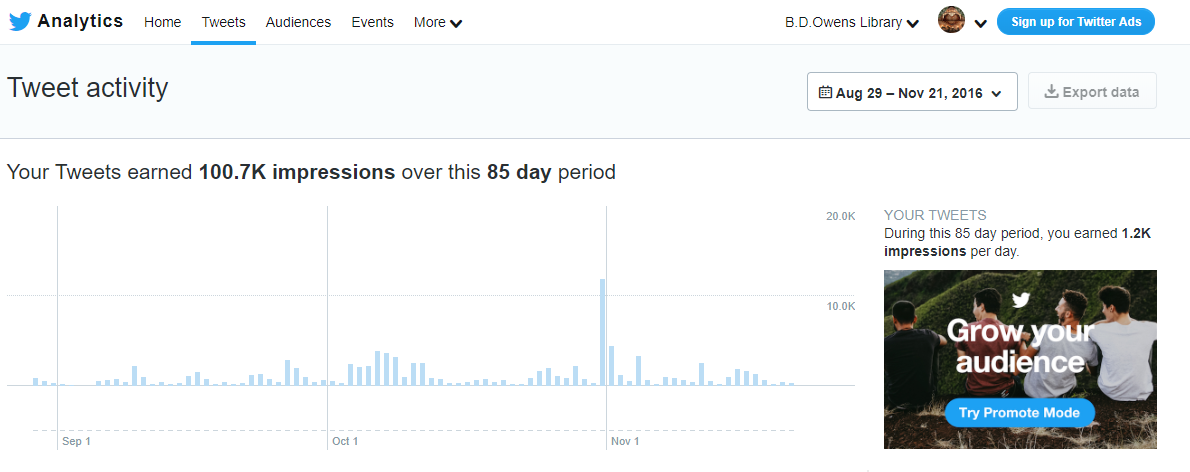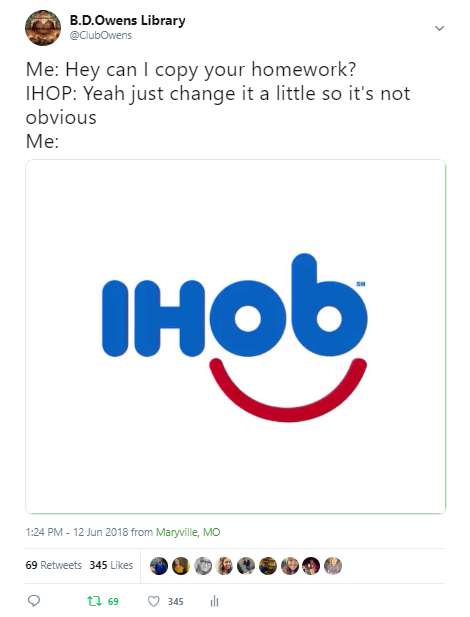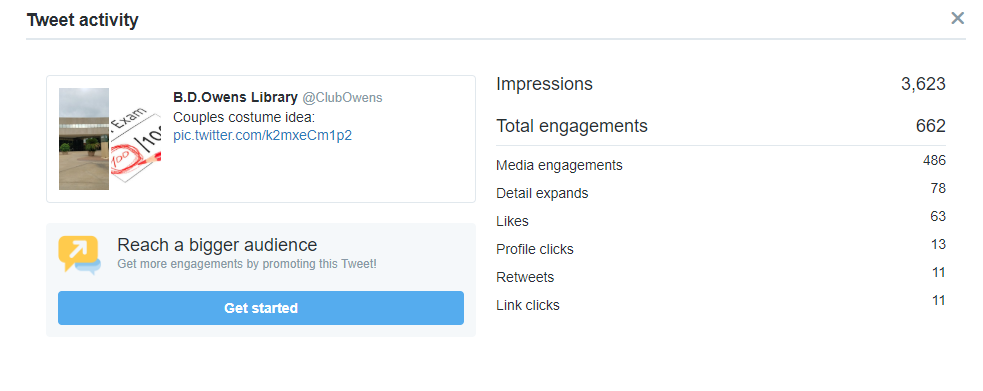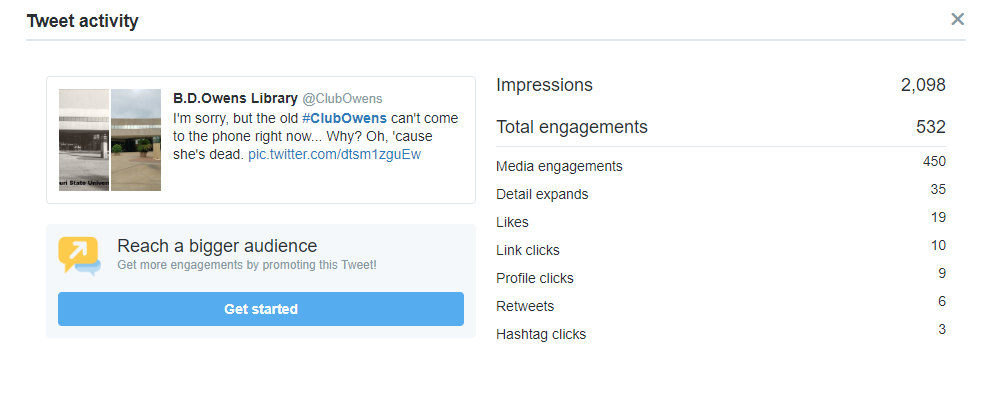Welcome to episode 008 of Library Figures. In each episode, we interview a new guest and hear about one of their favorite marketing strategies. In this episode, Hannah Christian of Northwest Missouri State University will be sharing her social media strategies that tripled her Twitter following and made use of trending topics to engage her audience.
As library marketers, it’s important that we recognize, our likes and dislikes are probably not the same as the likes and dislikes of our audience. This disconnect, all too often translates, into us creating content we LOVE but that our patrons aren’t interested in. It often means we use language and terminology that we understand, but our patrons don’t.
That’s just one reason we really liked Hanna’s approach to managing social media for her library. She talks about how she empowered her staff to be the voice of the library, the type of content they leveraged, how they continued to engage their audience, and much more.
“I think to understand virality you have to understand the nature of your followers.”
-Hannah Christian
Key Takeaways:
- What types of posts go viral
- Recruiting people within your target demographic helps you reach the right audience
- What types of strategies do Hannah and her team use
- How to stay on brand and engage your audience
Key Links Mentioned in This Episode:

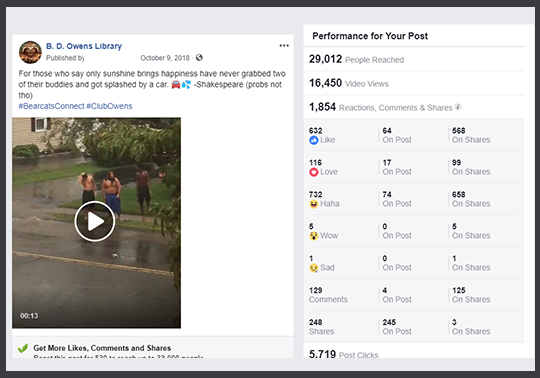
Read the Episode Below
[00:00:00] Hannah Christian:
Hi. This is Hannah Christian and I’m with Northwest Missouri State University. And this is Library Figures.
[00:00:18] Tyler Byrd:
Brought to you by Piola, the very first patron-inspired digital library branch. I’m your host, Tyler Byrd, and this is Library Figures. It’s a show about the people, data, and strategies behind some of the top-performing marketing campaigns in the library industry, and how they’re driving community engagement like we’ve never seen before.
Brought to you by Piola, the very first patron-inspired digital library branch. I’m your host Tyler Byrd, and this is Library Figures. It’s a show about the people, data, and strategies behind some of the top performing marketing campaigns in the library industry and how they’re driving community engagement like we’ve never seen before.
[00:00:38] Tyler Byrd:
So Hannah, thanks so much for being on the show today. I’m excited to have you up here and to talk about the topic. You and I had the chance beforehand to get together and discuss what you’ll be sharing with our guests and our listeners today, and I think that is something that a lot of them will find value from. But before we get there, why don’t you take a second and introduce yourself to our audience?
[00:00:59] Hannah Christian:
Well, thank you, Tyler. My name is Hannah. I am the Assistant Director of Career Services here at Northwest Missouri State University. And you may be asking, what does that have to do with the library? In my previous life I was a research librarian at the library here at Northwest, and so I worked in an academic library. I know a lot of your listeners are probably familiar with the other podcasts you’ve done over public library marketing, so academic library marketing is kind of a new or different beast for a lot of people that I’ve met at library conferences. So I was formerly a research and user experience librarian and I was in charge of the marketing for our academic library.
[00:01:47] Tyler Byrd:
Perfect. Actually, in our pre-interview I think I did ask you that exact same question like, what does that…
[00:01:54] Hannah Christian:
Exactly.
[00:01:54] Tyler Byrd:
…have to do with libraries? Yeah. So great intro, thank you. Now if I remember correctly, you actually presented at LMCC this year. Or well, last year now, right?
[00:02:05] Hannah Christian:
I did. I presented on five keys to social media success in academic libraries at LMCC in November of 2018. And that’s where I met the Red Rokk folks, the kind Red Rokk folks, and we’ve had some great conversations.
[00:02:23] Tyler Byrd:
Awesome. So tell us, so, what’s our conversation today?
[00:02:27] Hannah Christian:
Okay, so I have taken a little bit of extra thought now. Now that I’m Assistant Director of Career Services, it’s been a couple months since I’ve been doing marketing in libraries, so it was an interesting re-visitation of what were some of the strategies we were using to market and how were they working. And now that I have a little bit of a timeframe to reflect on what was working and what wasn’t working, I kind of went back and looked through the data, tried to pull some examples and some points to kind of help understand what was working for our library as far as engagement, and what wasn’t, and try to look for some counterintuitive data points or some type of measure that we could kind use to gauge usefulness of content or timeliness of content. And I think I pulled a couple of interesting insights out of the data as I was digging through it kind of posthumously, you might say.
[00:03:24] Tyler Byrd:
Awesome, I’m going to love this. So the data points and what you’re looking at is really back to what you talked about at LMCC, which is social media and engaging via social media accounts, right?
[00:03:36] Hannah Christian:
Exactly. A little bit of background on academic library. Our market, so to speak, is a very narrowly-defined market being the students who go to our university. So when you’re in a public library, you’re kind of engaging probably on a regional basis. You want to attract people who are in your region. We literally want the students who go to this university to actually come into the library and get help, and so we have a really narrowly-defined market and that troubled me for a while because I didn’t understand how to operate within those confines. And so I came up with a couple…we kind of stumbled on a couple strategies after failing at others that kind of helped us learn how to connect with students and engage very specifically with, I would say, 18- to 22-year-olds on Facebook and Twitter especially. Instagram came along later, Snapchat came along later. We don’t have a lot of data for that, to back that up, but just knowing what we were doing on Facebook and Twitter kind of helped inform our strategies for the others.
[00:04:47] Tyler Byrd:
Nice. So what would be an example of one of those?
[00:04:50] Hannah Christian:
So as I was combing through the data, I kind of tried to pull up, I have a couple of images, some examples of some posts that we would’ve called, quote, viral. So, I think to understand virality you have to understand the nature of your followers, right. So our Twitter account started out with about 400 followers. We have 5600 students on this campus, so 400 Twitter followers and, like, 5 of them are librarians, you got to remember that, so the actual librarians on campus.
So we started out with about 400 followers and by the end of our tenure we had added about, I would say about a thousand followers. I think there’s still actually right about 1400 followers, so we added about a thousand followers in approximately a two-year timeframe. So we doubled every year. Well, not quite at the end, but we were adding Twitter followers at a pretty rapid rate for an academic library Twitter account considering that our audience was fairly small and we were being very specific in some of our content.
2016 Tweet Activity
2017 Tweet Activity
[00:05:59] Tyler Byrd:
So that’s good growth. And those followers were pretty targeted as far as them being affiliated to the university at that point, right?
[00:06:11] Hannah Christian:
We tried really to encourage student accounts to follow us. We were grateful… There are always Twitter accounts out there with random 14,000 followers, and we were grateful for those, but we specifically wanted on-campus traditional student accounts.
[00:06:30] Tyler Byrd:
So when you’re looking at that and you’re looking at the virality and keeping that in perspective, what’s an example of a post that you would suggest or that you guys utilized to kind of help drive that forward, that you found success with?
[00:06:43] Hannah Christian:
So we learned pretty quickly that, as a staff member, even though we were on Twitter at the time, we didn’t really have an understanding of the youth culture on Twitter. So recruiting students to help run especially the Twitter account, knowing that they were going to be…have their pulse kind of on what was going on in the greater culture on Twitter. So there are a couple of tweets that I included with this. One of them actually was just this past summer, I had a high school job shadow student creating and posting a couple pieces of content, and she had created a post about the IHOB incident. Right, IHOP and they went to burgers and so they were IHOB. And so she just created this simple, little, cheeky tweet about: Me, “Hey, can I copy your homework?” and then IHOP was like, “Yeah, let’s change it a little bit so it’s not obvious.” It was like a super-cheeky kind of dig on cheating on your homework. So virality in this case was — and granted this is an academic library account in the summer, so we don’t even have really students on campus — we got 69 retweets and 345 likes on that post.
[00:07:55] Tyler Byrd:
That’s fantastic.
[00:07:56] Hannah Christian:
Yeah.
[00:07:57] Tyler Byrd:
Was that this summer?
[00:07:58] Hannah Christian:
That was this summer. This was June of 2018.
[00:08:02] Tyler Byrd:
Wow, nice. So, I like it. What she did is she took something that was trending and hot as far as a topic goes in that moment, and then she combined that with something that was relevant to your target audience in a way that they would see it and understand both and then engage with it, essentially.
[00:08:19] Hannah Christian:
Exactly. And college students love that. They love the trendy, but then they love having that viewpoint of, hey, our life kind of sucks right now, we’re studying for finals and we only eat ramen. And so you have to kind of toe the line between “we are giving you information about your research paper” and “don’t cheat on your test” and IHOB and all of the various cultural things that are going on out there.
[00:08:44] Tyler Byrd:
Yeah, that’s an excellent example. So the other thing that strikes me, though, is that, in order for that to work and for her to have been able to identify that and really leverage that strategy, she was able to do it because she’s essentially the target audience and knows what they want and what they’re willing to engage with. Right?
[00:09:03] Hannah Christian:
Exactly. So that was kind of the major point of my LMCC presentation, was that I, at the beginning of tenure, figured out that I was never going to be able to hack the 18-to-24 mindset because I have never been… I am one of those people with a 95-year-old brain. I just literally have never been 18 to 22 or 24. I literally live like I’m an old person inside. But I knew that, I was self-aware enough to know that, so I just recruited students to help me to be able to produce that content, and then I guided them in posting and how to create content, how to post content that was relevant and also pertinent to library situations.
[00:09:54] Tyler Byrd:
Were you taking that post because it did so well on Twitter and sharing it on Facebook as well? Or is the strategy on Facebook different?
[00:10:01] Hannah Christian:
So ultimately, we started out like a lot of other libraries do using Hootsuite or some of those other things to kind of mass post, and then we moved away from that, and then we moved into kind of a hybrid model of… Yes, so I actually don’t think that post got reposted on Facebook. I can’t exactly remember, but we had moved more toward a strategy of, hey, this is doing super well on Twitter, it probably is resonating with our audience so we should post it on Instagram, we should post it on Facebook, we should continue to take advantage of that content and use it on other platforms.
[00:10:45] Tyler Byrd:
So do you have an example of something that worked really well for you on Facebook, then?
[00:10:49] Hannah Christian:
So I do, and some academic librarian. So all these posts that I’m talking about are more fun posts, they’re not real content-rich as far as, hey, we can provide you with all these resources. But I think it’s important to remember that, when these posts are liked and viewed and retweeted, that increases your visibility on the platforms so that then you can follow up. And we like to use a strategy of, you bring in the heavy bomber, the funny gif or the funny tweet about IHOB, and then you machine gun them with, “Hey, you can use this for your research paper,” “Hey, librarians are here to help you.”
Tweet: “Couples Costume Idea”
Tweet: “I’m sorry, but the old #ClubOwens can’t come to the phone right now… Why? Oh, ’cause she’s dead.”
[00:11:31] Tyler Byrd:
I think that in itself is worth gold. I’ve seen that strategy work so many times where that popular viral content piece drives 300, 400 times the engagement, or better a lot of times. And what happens is that second piece that you follow up with now has even better engagement than anything that was organic before. It doesn’t get the same as the viral, but it’s still way better than anything else you’d get. So if people are using that strategy, that’s a fantastic strategy.
[00:12:03] Hannah Christian:
It’s very powerful.
[00:12:06] Tyler Byrd:
Hey everyone, I wanted to take a second and tell you about a project I’m really, really excited about. We’re launching a new digital library branch. It’s called Piola and you can find it at meetpiola.com. Piola is based on thousands of hours of research on user behavior, specifically patrons and how they’re using current websites and current technologies. Everything from heat maps to video recordings to focus groups to user testing, Google Analytics reviews, content audits and a whole lot more define exactly what patrons want and expect from a library website. We’ve taken all of that information and we’ve rolled it into a single product that you can get real quick, launched in less than 30 days, at the most affordable price of any website available to libraries. If you’re interested, we’re offering some demos and we’d love to get you to take a look. Head on over to meetpiola.com and check it out. I think that you’ll be really impressed because there’s nothing else like it on the market. Thanks.
[00:13:11] Hannah Christian:
So regarding the Facebook post, this is a similar… This was actually a well-executed example of doing that re-indexing of “this post is doing awesome so we’re going to post it other places.” What happened was… And this was actually 2018, a fairly recent post as well, and I shared it as well, a copy of that and the performance from Facebook Insights.
So what had happened was it had been raining here. It hadn’t rained all summer and then we had this deluge of just water was pouring down, and my social media assistant at the time had taken just a funny gif of these three guys standing by the side of the road, and every time a car drove by it would splash them. And so he wrote something cheeky like, “For those who say only sunshine brings happiness, they’ve never grabbed two of their buddies and gotten splashed by a car.” And then is says, it was like a quote by Shakespeare, but then he said, “Probs not.” And so he posted that on Facebook originally, and I think we have an approximate reach of 29,000 people. And I think you’ve got to keep in mind our Facebook page has also maybe 1300 likes, so it was a pretty incredible reach for a simple, cheeky Facebook post. And we were able to follow up then with some really targeted research-type posts and then get some better reach on those posts.
2018 Facebook Post
[00:14:38] Tyler Byrd:
Yeah. That seems like it falls right back into that first example you gave where it was popular, trending content that people were engaging with but still relevant to the target audience and the target demographic, and so it resonated. Would you agree?
[00:14:52] Hannah Christian:
I would totally agree. But I think there’s also one more ingredient that a lot of times, especially people who are running accounts for an entity like a library, I think they forget one simple piece and that is when students or when people are responding to your posts, when they’re sharing, when they’re commenting on it, you should jump right into the fray and you should reply to their comments and you should say cheeky things when they make funny comments on their posts, because that combination of hitting that viral post and then re-engaging with the comments and re-engaging with the sharing, I think that is the one-two knockout punch right there.
[00:15:36] Tyler Byrd:
Yeah, I like that. Good build up, by the way. I was like, what is it, what is it? That’s perfect. So the other thing that I’m starting to think about as you talk about your strategy and what’s been working for you is that this works really well also, because it seems like your audience is so hyper focused, that when you deliver content to them it’s really relevant to a lot of your audience members versus just a small subset of 10 percent of them. And so because it’s relevant to such a high portion, they’re engaging with it at a higher rate than what we might see on a broader scale if you’re a national organization.
[00:16:16] Hannah Christian:
Exactly. And I think you talk about a narrow scale, you have to remember that our target audience is already really narrowly defined. So we’re going to have, everybody’s going to respond or nobody’s going to respond. We have a pretty binary reaction to our content. It’s either dead, crickets or it’s like, “Yeah, yeah, yeah! That’s exactly right!”
[00:16:37] Tyler Byrd:
Yeah, that makes sense. So when you’re looking at that, what I’m curious about, you’re bringing in these students that help you out, they don’t work for the school up to that point I’m guessing. Maybe they do. But how do you manage them? Students seem like they could say anything and you want to be careful about whether it’s within the brand and whether it’s relevant and whether it’s something your organization really wants to be saying and have out there. So how did you manage that process to make sure that it’s on target?
[00:17:06] Hannah Christian:
Great question. When I first took over, this was a real…I think in libraries this was a real heavy conversation. Everyone was very concerned about… Well, half the camp was very concerned that the posts were going to go off brand, the other half of the camp was just replying with funny gifs. And so I kind of tried to take the “we’ll learn by doing” approach. And so right off the bat I gave my social media assistant, my student employee, I gave them full responsibility for the account. And I told them, “Everything that you post on here will be seen as a university entity posting on this library account.”
And to date I had exactly zero examples of students going rogue. They took the responsibility very seriously and executed flawlessly. There were a couple times when they kind of pushed the envelope a little bit and the administration would come down and say, “Hey, you can’t have a meme war with Central Missouri,” or, “Hey, what are you doing?” because they didn’t understand the nature of that cutting-edge type of student-focused content. But overall, the students were, they were just very responsible and very on brand. They had created the brand, so they had ownership of it.
[00:18:29] Tyler Byrd:
Okay, that makes sense. So you set good expectations up front and then you make sure to also enforce them on an ongoing basis, it sounds like.
[00:18:37] Hannah Christian:
And the other thing that I did was, as the staff member responsible for them, I made sure that administration, I took all the flak. I gave them all the credit for posting and all the credit for the content, and I took all the flak from everyone else. And that freed them up to be confident to take a few risks here and there about posting content, because they knew that if I was upset by it or thought it was off brand, I would speak to them privately, I had their trust, but that I would take all the heat and all the flack. And I did get phone calls. I got phone calls from university marketing about a few hashtags that we weren’t allowed to use, and I just simply used it as a teaching moment. “Hey, marketing doesn’t want us… We’re kind of veering off brand here. We got to get back on track.” And then, as anyone who manages social media knows, if you posted it on Twitter yesterday, it’s in the archives, it’s way gone. You shouldn’t be thinking about that anymore, you should be thinking about the next tweet.
[00:19:34] Tyler Byrd:
Yeah. So if we have a library out there and they’re looking at their social media accounts right now and they’re trying to figure out, how can we improve the content and the engagement, is there anything that you would share with them and that you’d tell them that they should start focusing on right away that would help them out?
[00:19:50] Hannah Christian:
Sure. A couple things. So very basic things. Be very consistent in the amount of posting, so look like you’re on Twitter enough time that you look like you’re a Twitter native. Be on Facebook an appropriate amount of time to look like you know what you’re doing on Facebook. So be very consistent in your posting schedule, and sometimes, when you have to come up with content and post, that’s hard to do, but just develop that daily discipline of posting. I’d say that’s number one. Number two, and this was a huge learning experience for us, number two was, as much video as you can stomach, live video, clips of things happening in the library.
The more video — that metric I told you at the beginning — all of our insights, our reach, all of our engagement went up as we doubled down on disciplined posting of video content. So I also have a screenshot there of a week of our Facebook content and it shows some links that we posted and several videos that we had shared, and as you can see, the engagement and the reach just continued to go up as we put ourselves out there in a video format.
[00:21:12] Tyler Byrd:
Okay, that makes sense. And to everyone who’s listening that’s interested, Hannah’s referred to a couple different images and screenshots that she sent over so that you can get a visual and see exactly kind of some of the things that they were doing. We’re going to put those up with the podcast on our blog at meetpiola.com. So you can head over there and check out the visuals and see firsthand what some of these things look like and what the results were too. Hannah, similar question. Is there anything that you would tell them to avoid that you maybe ran into and you kind of ran into a wall or a barrier that, going back in time, you would do differently or you’d suggest to someone else to do differently?
[00:21:50] Hannah Christian:
Yes. This was my favorite part, actually. In the fall of 2017, I was super excited about the video content. So that’s why there is a huge uptick in all of our platform video content for that fall semester. I was committed to video. I was ready to go, I was going to be the behind-the-camera person, I was willing to be in-front-of-the-camera person.
We did so many types of video, and we did live videos, we tried to do some produced videos. We just overwhelmed our viewers with different types of video content. And I learned pretty quickly that, in order for the video to really be successful, you need to have a personality who’s willing to be on camera. So I became this annoying video person to all my colleagues. I would say, “Hey, you’re going to be on video today,” and they would yell and kick me out of the office. After the first three weeks, I became a pariah because they were like, “Get away from me, you and your video camera.” So I was alienated there for a while. It was helping my social media, but it wasn’t helping my collegial relationships.
[00:23:05] Tyler Byrd:
Interesting. That’s an interesting side effect.
[00:23:08] Hannah Christian:
It is. It was totally un… I was totally unaware of the fact that many people really hate the thought of being on video.
[00:23:17] Tyler Byrd:
Yeah, the introvert, shy, whatever it might be, but that’s a tough one. All right, perfect. So we’re coming to the end of our show for the day. I wanted to, I got a couple questions I know I haven’t told you about. They’re kind of on-the-spot rapid-fire questions I’d love to throw at you and get your thoughts on. So with that said, are you ready?
[00:23:39] Hannah Christian:
I’m ready.
[00:23:40] Tyler Byrd:
Okay, cool. This should be pretty easy. What’s your favorite source for staying up to date with new marketing ideas?
[00:23:46] Hannah Christian:
Well I just do Google searches. If I have a question, I’ll just blah, blah, blah, blah. HubSpot is good, HubSpot sends out a weekly digest, or at least that’s what I opted to get. They had a lot of good information. I listen to Gary Vaynerchuk, lot of good information.
[00:24:01] Tyler Byrd:
Nice, nice.
[00:24:02] Hannah Christian:
Am I supposed to say Red Rokk?
[00:24:03] Tyler Byrd:
No, no. Actually, no one’s ever said that yet, but thank you.
[00:24:09] Hannah Christian:
If you’re in the library space, you should obviously check them out because they’re working on it pretty in depth.
[00:24:16] Tyler Byrd:
Thanks. We did not pay her for that plug, I promise. No, HubSpot’s a great source. That’s a great one. And Gary Vaynerchuk, good content there. Especially if you’re looking for video examples, he does a great job with that. Next question. What’s a book you haven’t read yet but you really want to?
[00:24:36] Hannah Christian:
So I read a lot, because I’m a librarian, right. I read 137 books last year.
[00:24:41] Tyler Byrd:
Whoa, well done.
[00:24:42] Hannah Christian:
So a book that I am actually… So, Bill Walsh, The Score Takes Care of Itself. That’s actually next on my reading list. Haven’t read it yet, looking forward to it.
[00:24:53] Tyler Byrd:
Okay, that sounds interesting. So content. What’s your preference, digital or print?
[00:24:59] Hannah Christian:
Half and half. I don’t like reading longform content online, so if it’s longer than 5,000 words, I’d rather have it printed out.
[00:25:08] Tyler Byrd:
Yeah, I fall into that bucket. How about favorite library service?
[00:25:13] Hannah Christian:
Ooh, that’s easy. IOL. Any form of borrowing from a multi-library consortium, or any type of loner service, because I read so many books, often they’re not available here. And so the most amazing thing about libraries is that they’re all connected in some way, and if somebody has that book, they can get it to you somehow.
[00:25:36] Tyler Byrd:
I have not had that answer yet, that’s a great answer. All right, last question for you. Is there someone in the marketing space, whether inside of libraries or out, that you think does a great job that you’d like to hear us interview on the show?
[00:25:52] Hannah Christian:
I am not sure of the exact person, but do you guys remember Kansas City Royals in 2015 won the World Series? Do you guys remember? Kansas City Public Library had a war going on with San Francisco. Was it San Francisco, they played the Giants? Do you remember they had the book? They stacked up the titles and they were poking fun at them?
[00:26:18] Tyler Byrd:
No.
[00:26:18] Hannah Christian:
They had this Twitter war going, Kansas City Public Library, and I thought that was kind of a national… They had their 15 seconds of fame. I do not know who is behind that, but whoever did that was a marketing genius.
[00:26:32] Tyler Byrd:
All right, I got to find this.
[00:26:33] Hannah Christian:
That’s who you should get.
[00:26:34] Tyler Byrd:
Okay, done. You’ve given me a goal for the quarter, I got to figure out what this is and who came up with it and ran it. That sounds really fun. All right, Hannah, so, thank you so much for taking the time today. If we have some listeners on the show that have more questions and wanted to reach out to you and touch base, what would be the best way to get in contact?
[00:26:453] Hannah Christian:
Best way is probably — and I talked about all these social media platforms — best way is probably LinkedIn. Hannah Christian, LinkedIn.
[00:27:02] Tyler Byrd:
We’ll put a link in the show notes so anyone who is interested, you can find the link in the show notes as well. Hannah, with that we’ll wrap it up. And I just want to say thank you very much for being on the show today. I really appreciate it.
[00:27:13] Hannah Christian:
Thank you, Tyler.
[00:27:13] Tyler Byrd:
And I myself learned a lot, so, thanks.
[00:27:15] Hannah Christian:
It was fun, I appreciated it.
[00:27:19] Tyler Byrd:
Alright, before we head out just a couple more quick things. If you know somebody that you think would be a great guest on this podcast and you’d like to hear us interview them, I’d love the opportunity. Send me their name and their contact information at hello@meetpiola.com, that’s hello@meetpiola.com, and I’ll do all the hard work of reaching out and getting them scheduled so that all of our listeners will have the opportunity to learn more from them about the great marketing strategies that they might be using. We’re constantly looking for new guests and great guests on the show, and I would really appreciate the opportunity to meet with your connections and get them up here, to learn more.
Second, if you’re enjoying the podcast episodes and so far you like what you hear on Library Figures and the content, head over to iTunes. You can subscribe to the podcast to get future episodes, and while you’re there, if you could give us a five-star rating that’d go a long way in letting us know that you like the content and you like the show and we should continue doing it.
All right. Until next time, all, I look forward to being on air again and the next great interview we’ll have up. Take care. We’ll see you next time.




